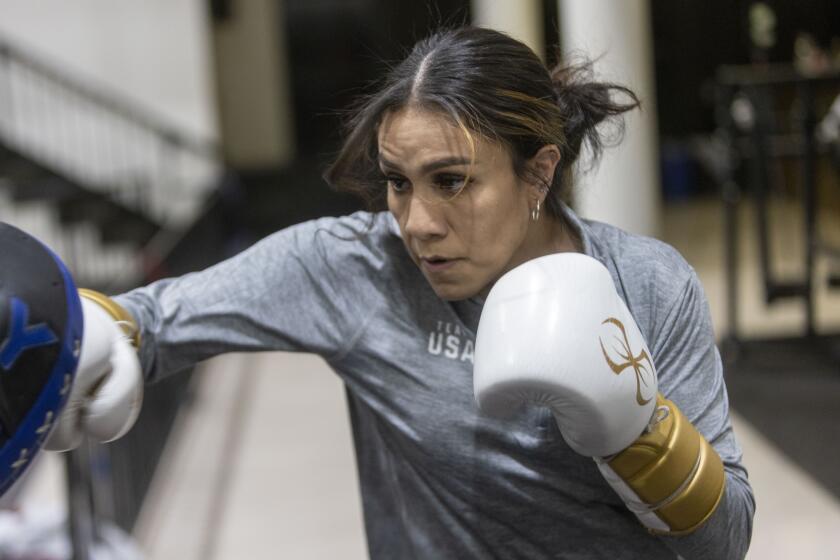Just getting in the ring is his ultimate fight
Can a man without fists or feet enter the ring as a mixed martial arts fighter?
This is the question posed by Kyle Maynard, a 21-year-old from Georgia who was born without arms below the elbows or legs below the knees, a condition called congenital amputation.
After notching a formidable reputation as a high school wrestler -- winning 35 matches at the varsity level and placing in the top 10 in the state tournament -- he wants to compete in mixed martial arts, the extreme combat sport that involves clinching, pinning, punching, pummeling, chopping and dropkicking.
Getting a license, however, is no simple feat.
The Georgia Athletic and Entertainment Commission voted to deny Maynard a license to compete in an amateur fight in September, citing safety concerns.
“The fights are brutal,” said J.J. Biello, chairman of the commission, who is paralyzed from the neck down. “I feel for the fellow, but I’ve also seen fighters carried off to ambulances on stretchers. In all good conscience, I don’t think Kyle can defend himself.”
Maynard plans to appeal the decision.
If he wins, he could become the nation’s first severely disabled mixed martial arts fighter. If he loses, he plans to sue the commission, alleging discrimination.
“I can defend myself,” he said in an interview. “I’m not going to get smashed against a cage or get my head stomped. People who are opposed don’t understand the rules, and they don’t understand my capabilities.”
Maynard would not be the first disabled fighter to compete in mixed martial arts, a sport popularized in recent years by the television series “Ultimate Fighter.”
In June, a Canadian, Baxter Humby, who is missing one arm below the elbow, fought in California after persuading the state’s commission, which initially denied his request, that he could offset attacks.
A fighter without fists or feet presents a more extreme challenge.
Georgia’s athletic board dismissed the license on the grounds that Maynard would not be safe.
But some fans think Maynard would not really be practicing mixed martial arts, or that he could somehow taint the reputation of the sport that Sen. John McCain (R-Ariz.) once dubbed “human cockfighting.”
“This isn’t a freak show,” said one fan on MMA.tv, a mixed martial arts website that has been inundated with posts about Maynard.
Mixed martial arts can be traced to the 1920s and Brazil’s sensational vale tudo -- “anything goes” -- tournaments. In recent years, it has gained mainstream appeal after banning head-butting and introducing weight divisions and a scoring system. Amateur tournaments are regulated by athletic commissions in about 20 states.
Most mixed martial arts experts seem to agree that Maynard’s disability would involve rule adjustments.
“The rules of this game are structured for people with legs and arms and hands and feet,” said referee John McCarthy of the Ultimate Fighting Championship, the world’s leading mixed martial arts sports association.
“I hate to tell anyone they can’t fight, but it has to be within reason. I’m not going to let a blind man get into a Formula One car and take it around the Indianapolis 500. Could a blind man do it slowly, with a radio? Sure. But can he really compete?”
If Maynard competed in amateur mixed martial arts, he would not be at risk from punches to the head or kicks because, technically, he would be considered a grounded opponent. Professionals are allowed to deal such blows to grounded foes, but amateurs are not.
Some experts say Maynard would not be participating in a true mixed martial arts fight if he were classified as grounded at all times.
But no rule says an opponent has to stand.
Indeed, the point of mixed martial arts is that competitors can choose their own style of fighting.
Maynard said fighting from the ground gave him distinct advantages: His 125-pound weight is concentrated in a smaller area, so he can take more blows, he said.
And he said he packed about 200 pounds of strength in the surface area of his elbow.
“A lot of people think, ‘How the heck are you going to strike?’ ” he said.
“Well, I don’t have super-long arms, but I can generate a lot of force with my elbow. If I can swing into their rib cage, plexus, kidneys or legs, it’s going to do some serious damage.”
But most mixed martial arts authorities, including those in Georgia, do not allow elbow strikes. This, McCarthy said, raises the question of whether Maynard’s limbs would be classified as elbows or fists.
“If we call it a fist, he has to wear a glove,” McCarthy said. “If we allow him to elbow, do we also allow his opponent to do so?”
Some wonder who would want to compete with Maynard.
“If you win, you’ve just been beating up on a guy who doesn’t have all his limbs,” McCarthy said. “If you lose, well, you can’t compete with a guy who doesn’t have all his limbs. And everyone at the show is going to be rooting against you.”
Maynard, a professional inspirational speaker who has appeared on “The Oprah Winfrey Show” and published an autobiography called “No Excuses” at age 19, is adamant that he is not asking for special favors.
For nearly two years he has been preparing for mixed martial arts tournaments, training with such acclaimed fighters as Robbie Lawler and Diego Saraiva.
“I just wish people would stop looking at my limitations and feeling sorry for me,” Maynard said. Of his quest to fight, he said, “I don’t know if it’s the ultimate test of someone’s desire, but I do know it’s the closest I’ve come to pure freedom.”
Biello said the Georgia Athletic and Entertainment Commission was particularly concerned about the possibility of fouls. After watching matches in which fighters had gotten so pumped up that they struck their grounded opponents in the face, Biello said he could not allow Maynard to enter the ring.
Such concerns dumbfound Maynard, who argues that he would be at no more risk of illegal strikes to the head than any other competitor.
Sitting in his living room, he waved a stump toward a poster of a young Muhammad Ali raising a clenched fist.
“This is my life,” he said. “I’ll fight this decision as hard as I can fight.”
--
(BEGIN TEXT OF INFOBOX)
Mixed martial arts
Styles: Mixed martial arts pits different fighting styles -- wrestling, jujitsu, boxing, karate, judo, kickboxing -- with few rules.
Techniques: There are two main fighting techniques -- striking, which includes kicks and punches, and grappling, which includes clinch holds and submission holds.
Off-limits: Biting, eye-gouging, hair-pulling, “fish-hooking” and small-joint manipulation are generally considered illegal.
More to Read
Go beyond the scoreboard
Get the latest on L.A.'s teams in the daily Sports Report newsletter.
You may occasionally receive promotional content from the Los Angeles Times.











